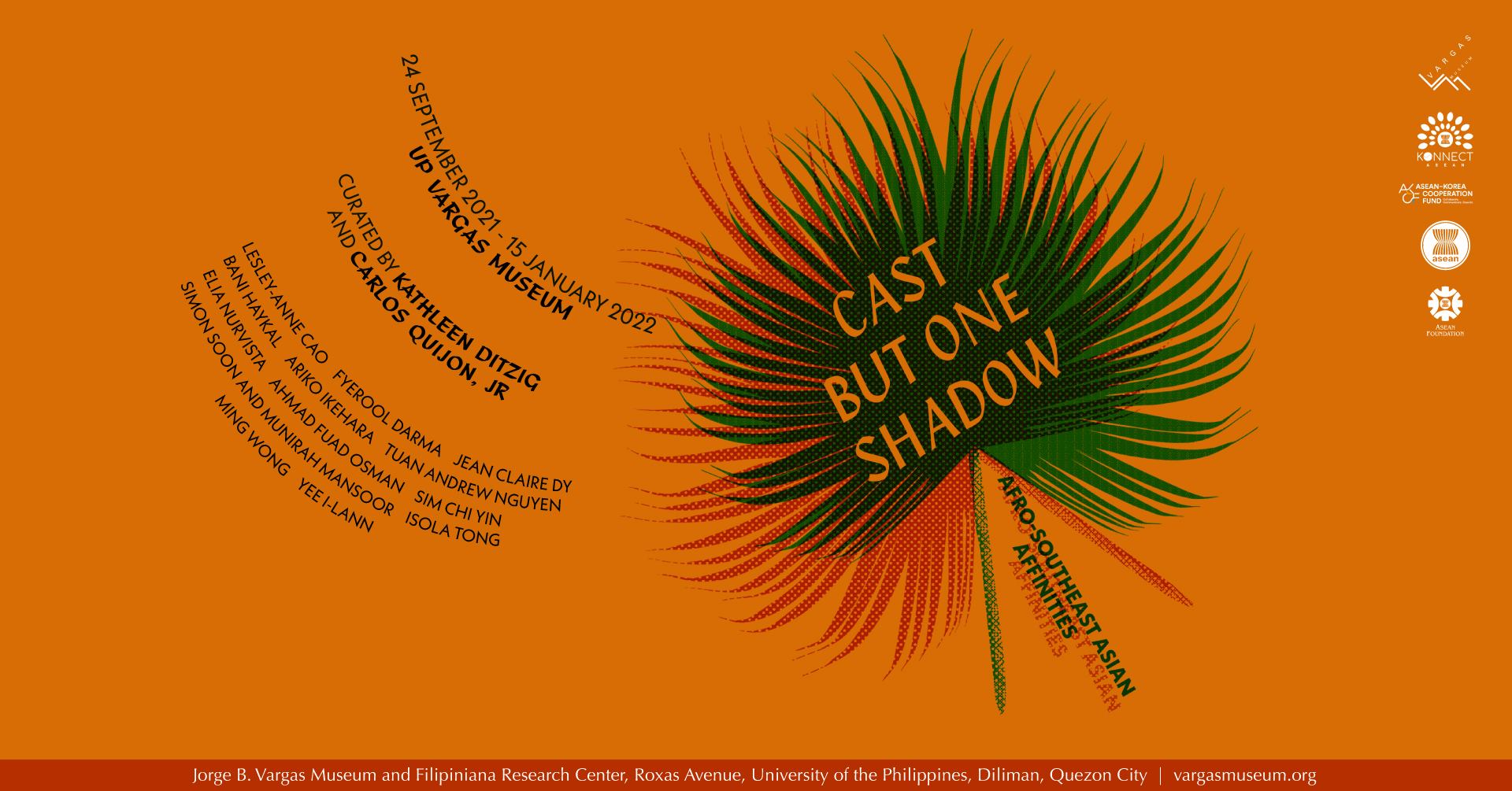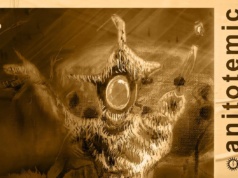Afro-Southeast Asian Affinities

24 September 2021 – 15 January 2022
UP Vargas Museum
Jorge B. Vargas Museum and Filipiniana Research Center, Roxas Avenue, University of the Philippines, Diliman, 1101 Quezon City, Philippines
Facebook Instagram Twitter Website
𝗪𝗶𝘁𝗵 𝗮𝗿𝘁 𝘄𝗼𝗿𝗸𝘀 𝗯𝘆 𝗟𝗲𝘀𝗹𝗲𝘆-𝗔𝗻𝗻𝗲 𝗖𝗮𝗼, 𝗙𝘆𝗲𝗿𝗼𝗼𝗹 𝗗𝗮𝗿𝗺𝗮, 𝗝𝗲𝗮𝗻 𝗖𝗹𝗮𝗶𝗿𝗲 𝗗𝘆, 𝗯𝗮𝗻𝗶 𝗵𝗮𝘆𝗸𝗮𝗹, 𝗔𝗿𝗶𝗸𝗼 𝗜𝗸𝗲𝗵𝗮𝗿𝗮, 𝗧𝘂𝗮𝗻 𝗔𝗻𝗱𝗿𝗲𝘄 𝗡𝗴𝘂𝘆𝗲𝗻, 𝗘𝗹𝗶𝗮 𝗡𝘂𝗿𝘃𝗶𝘀𝘁𝗮, 𝗔𝗵𝗺𝗮𝗱 𝗙𝘂𝗮𝗱 𝗢𝘀𝗺𝗮𝗻, 𝗦𝗶𝗺 𝗖𝗵𝗶 𝗬𝗶𝗻, 𝗦𝗶𝗺𝗼𝗻 𝗦𝗼𝗼𝗻 𝗮𝗻𝗱 𝗠𝘂𝗻𝗶𝗿𝗮𝗵 𝗠𝗮𝗻𝘀𝗼𝗼𝗿, 𝗜𝘀𝗼𝗹𝗮 𝗧𝗼𝗻𝗴, 𝗠𝗶𝗻𝗴 𝗪𝗼𝗻𝗴, 𝗮𝗻𝗱 𝗬𝗲𝗲 𝗜-𝗟𝗮𝗻𝗻
Hosted at the UP Vargas Museum in Manila (24 September 2021 – 15 January 2022), 𝐂𝐚𝐬𝐭 𝐁𝐮𝐭 𝐎𝐧𝐞 𝐒𝐡𝐚𝐝𝐨𝐰 is the second exhibition of a long-term and iterative research project by Kathleen Ditzig and Carlos Quijon, Jr. that situates Southeast Asia as a compelling coordinate to review the continued resonances of global solidarities. Developed in partnership with KONNECT ASEAN, an ASEAN Foundation arts program funded by the Republic of Korea, this three-year project focuses on Afro-Southeast Asian affinities that emerged from decolonization projects during the Cold War.
𝐂𝐚𝐬𝐭 𝐁𝐮𝐭 𝐎𝐧𝐞 𝐒𝐡𝐚𝐝𝐨𝐰 pursues the thematic threads of racial presence, anti-colonial struggle, and the interventive ways of navigating colonial and neocolonial relations through Southeast Asia. The title of the exhibition is adapted from a 1962 novella authored by Han Suyin, a Eurasian physician, novelist, and public intellectual with Chinese and Belgian parentage. It was one of the last books she published while living in Malaya, two years before she left the country in the wake of controversies involving her opposition to the merger of Singapore with the rest of the Malayan states into the Federation of Malaysia. The exhibition focuses on the complex regional historical milieu that Han worked in as an important source of illumination in the history of archipelagic Southeast Asia and the discourses around decolonial affinities.
The art works in the exhibition are research projects that both interrogate histories and speculatively project history into the future. For example, Tuan Andrew Nguyen’s The Specter of Ancestors Becoming (2019) examines the history of the Tirailleurs sénégalais, Senegalese soldiers deployed to suppress Vietnamese uprisings against French rule, and the enduring legacies of colonial prejudice and imaginations of power through the perspectives of Vietnamese-Senegalese descendants; Lesley Anne Cao’s AI-aided fabrication of lingling-o, jade ornaments that have circulated across mainland and maritime Southeast Asia and Taiwan, attests to the intricate intimacies among territories in the South China Sea; and, Ahmad Fuad Osman’s artistic research looks at the life and time of Shaykh Yusuf of Makassar, a 17th century Sufi scholar who was exiled from Makassar to South Africa by the Dutch and while there was instrumental in the formation of the Muslim community at the Cape of Good Hope, eventually known as “Cape Malay.”
Beyond art works that flesh out transregional communities of exchange, the exhibition also features art works that examine specific Cold War political imaginations of race and affinity. An installation by Elia Nurvista on the history and politics of international food aid programs, Ariko Ikehara’s community project on Teruya, a “black district” in Okinawa (1950-1970s), and bani haykal’s sound installation that examines America’s jazz diplomacy in Southeast Asia, unravel the complicated legacies of racial segregation and the historical consequences of the discourse of the color line, Cold War entanglements of Civil Rights movements, and the expansion of American empire after World War II.
Art works by Fyerool Darma, Simon Soon and Munirah Mansoor, and Yee I-lann cast a regional lens upon the enduring legacies of such Cold War era imaginations of affinity by speaking to imaginations of Maphilindo, a short-lived confederation in 1963 between then Malaya, Indonesia, and the Philippines. Maphilindo was built on a shared imagination of a civilizational and racialized pan-Malayan identity that spanned archipelagic Southeast Asia, Polynesia, and as far as Madagascar. The confederation was the precursor to the Association of Southeast Asian Nations established in 1967.
Engaging specifically with how “Chineseness” was understood within this historical milieu, newly commissioned work by fictionist and filmmaker Jean Claire Dy unpacks her family history of being Chinese in the Philippines; photographs by Sim Chiyin mines the British Imperial War Museum’s archive for the residual traces of the trope of the “bandit” and the anti-colonial jungle fighter in the history of the Malayan emergency; and Ming Wong’s video poem Hand-in-Hand (2019) sees him take on the role of cultural ambassador visiting contemporary infrastructure, such as the Museum of Black Civilizations, built in Senegal with China’s aid, implicitly illustrate how racial connotations are tied to geopolitical struggles and dominant world systems.
Alongside the art works, the exhibition converses with the library and art collection of the Vargas Museum as well as a range of historical materials. These materials focus on the transnational cultural production of Han Suyin, diplomatic gifts of paintings from former Indonesian President Sukarno to his contemporary Philippine President Diosdado Macapagal, and cinematic projects like Apocalypse Now (1979), and Blaxploitation films, such as the 1974 movie Savage Sisters that was directed by Eddie Romero, films wherein the jungles of the Philippines stand in for Vietnam and Latin America and in doing so conflate neocolonial imaginations of the “Third World.”
A newly commissioned outdoor installation by architect and visual artist Isola Tong elaborates on these historical conjunctures using the Philippines as an entry point. Tong’s research mobilizes the human-animal hybrid tropes of the 1972 Blaxploitation film Twilight Men and looks at the Marcoses’ importation of safari animals from Kenya to create the Calauit Safari Park in Palawan, displacing its indigenous peoples.
From the color line to Maphilindo, to contemporary retrospections upon Cold War solidarities, 𝐂𝐚𝐬𝐭 𝐁𝐮𝐭 𝐎𝐧𝐞 𝐒𝐡𝐚𝐝𝐨𝐰 takes heed of how race and racial presence informed arguments for sovereignty and expansive imaginations of the region during the Cold War and how these imaginations endure and color our contemporary world.
The third and final iteration of this project will be presented in the Republic of Korea in 2022. The project represents one of the first initiatives by the ASEAN Foundation to examine an expanded and global history of Southeast Asian regionalism.
About KONNECT ASEAN
ASEAN has, since its inception, done much to facilitate people-to-people exchange in the arts sector across Southeast Asia to encourage dialogue and debate. This unique space for artistic discourse that allowed for pluralistic notions of what constituted a regional artistic identity and aesthetic is one of ASEAN’s great legacies and is widely discussed, researched, and acknowledged by a new generation of art historians and curators.
In 2019, the Republic of Korea celebrated 30 years of diplomatic relations with ASEAN. In the same year the ASEAN-Korea Cooperation Fund (AKCF) supported KONNECT ASEAN – An ASEAN-Republic of Korea Arts and Cultural Program. Administered by the ASEAN Foundation, KONNECT ASEAN signals both an eagerness by ASEAN to revitalize its once integral role in contemporary visual arts and Korea’s sincerity in establishing closer ties with ASEAN.






























